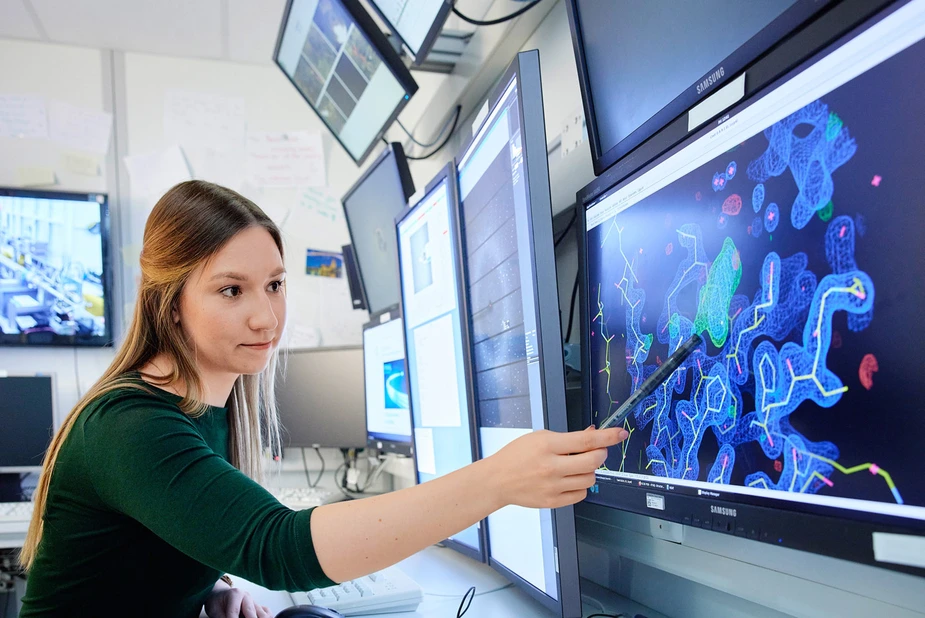Synchrotrons accelerate corona research
Research funding is key – Information by the German Committee Research with Synchrotron Radiation
Synchrotron light sources were originally built to study particles. Today, they are even used in the fight against COVID-19. The projects are as diverse as the fields of the synchrotron users, who come from universities, research institutions and companies like BioNTech.
To fight COVID-19, we need vaccines and medicine, and to develop these, we need to know the SARS-CoV-2 virus in detail. The virus cannot be seen with a normal light microscope, since it is smaller than the wavelength of visible light. Synchrotrons can produce the short-wave photons or X-rays required. It is of great advantage that we have an outstanding research infrastructure established in the last decades, both in Germany and abroad with German participation. Synchrotron light source facilities include PETRA III and FLASH at the German Electron Synchrotron (DESY) in Hamburg, BESSY II at the Helmholtz Centre Berlin (HZB), European XFEL near Hamburg or ESRF in Grenoble, France. They allow the virus to be imaged with atomic precision.
“The special feature of these large-scale research facilities is that a large community of users can work on their burning questions there. The supply of state-of-the-art methods makes synchrotrons extremely attractive, also and especially for corona research“, says Prof. Dr. Jan-Dierk Grunwaldt (KIT), chair of the German Committee Research with Synchrotron Radiation (KFS).
The heart of a synchrotron is a particle accelerator which accelerates electrons to almost the speed of light. Special magnets deflect the electrons from their trajectory in the synchrotron as they are slowed down, they emit energy in the form of light. These photons, which cover a wide range from infrared to X-ray, are used to study chemical processes, cells and molecules, but also, for example, the spread of aerosol particles or the extent of damage to the lung tissue of COVID patients.
Shortly after the genome of the novel coronavirus SARS-CoV2 was published in early 2020, the first studies started at German synchrotron radiation sources. While synchrotron measurement time normally has to be applied for several months in advance, the synchrotron radiation sources set up a fast-track procedure for coronavirus researchers. They maintained operation for these projects even during the lockdown. This allowed a wide variety of projects to be conducted.
Exciting projects on Corona
- In February 2020, the three-dimensional structure of the main protease of the virus was decoded by X-ray structure analysis in Berlin. The main protease is an important target for drugs against COVID-19. In a project at BESSY II with the universities of Lübeck and Hamburg, possible binding sites are being investigated. One promising substance has already been identified.
- When the 3D molecular structure of the main protease was known, around 7,000 approved drugs were tested at DESY for possible efficacy against the SARS-CoV-2 virus in a large-scale "X-ray screening" in a cooperation between DESY, the Universities of Hamburg and Lübeck, the Bernhard Nocht Institute for Tropical Medicine and Fraunhofer IME. At PETRA III, 37 active substances were identified that bind to the main protease. Two of these active substances are already in the preclinical test phase.
- The Mainz-based company BioNTech, which developed one of the first coronavirus vaccines, is conducting research at PETRA III together with university partners to improve RNA vaccines.
- Experts are using PETRA III to look for innovative ways of administering coronavirus drugs with the aim of mitigating possible side effects.
- A team from FU Berlin and HZB visualized coronaviruses in cells using the X-ray microscope at BESSY II. They are currently investigating how virus uptake is blocked by clinically approved antidepressant drugs. Antidepressants influence finger-shaped protrusions of the cell, the so-called filopodia. Since the virus also binds to these filopodia, the antidepressants can be used to investigate whether these structures play an important role in the infection.
- For the development of drugs, it is important not only to know structures, but also to understand which processes take place. The question of how substances bind to the coronavirus is particularly interesting. Unique insights into these fast processes have been gained by international research collaborations involving DESY at the European XFEL.
- Entire lungs of COVID-19 patients were studied at the ESRF with the aim to map the entire human body with extremely high resolution (Human Organ Project). Led by the University College London and the ESRF, this work is in cooperation with the Universities Hannover, Heidelberg and Mainz.
- At PETRA III, researchers from the University of Göttingen have used an X-ray method originally developed to study brain tissue to examine damaged lung tissue from COVID-19 patients with unprecedented high resolution. The fundamental understanding of the effects of COVID-19 is the basis for better therapies.
- A team from the MPI for Chemistry in Mainz and the MPI for Dynamics and Self-Organisation in Göttingen is using microspectroscopy at BESSY II to study the emission and properties of aerosol particles during various activities such as speaking, singing or coughing, in order to better understand their role in the transmission of pathogens.
“These achievements are no coincidence but the result of consistent and long-term research funding. It was very fortunate for the fight against the pandemic that we have this research infrastructure in Germany. Good research simply takes longer than a legislative period.“ says Dr. Andrea Thorn (Uni Hamburg), head of the Coronavirus Structural Task Force and member of the German Committee Research with Synchrotron Radiation (KFS).
The KFS is an elected body which represents more than 4000 users of synchrotron radiation sources in Germany and at international institutions with German participation.
Further information:
Contact:
German Committee Research with Synchrotron Radiation (KFS)
Dr. Karin Griewatsch
KFS Press Office
kfs-presse(at)sni-portal.de
Helmholtz-Zentrum Berlin für Materialien und Energie (HZB)
Dr. Antonia Rötger
HZB Press Office
Phone: +49 30 8062-43733 / -42998
antonia.roetger(at)helmholtz-berlin.de
Press release HZB, 29 June 2021
